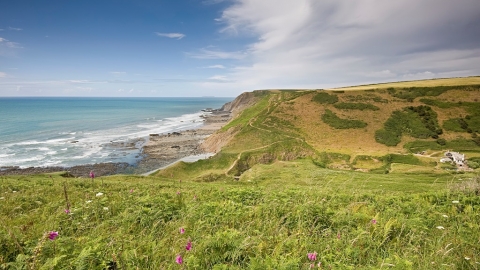
Photo, Dave Chamberlain
Know before you go
Dogs
When to visit
Opening times
Open at all timesBest time to visit
March to OctoberAbout the reserve
Few people forget their first visit to Marsland nature reserve. At 212 hectares it's one of our biggest reserves. But even at this size it retains a feeling of intimacy and an air of secrecy.
Ash dieback
The disease ash dieback is now widespread in the UK and is present at many of our nature reserves, so we carry out tree felling across our sites in winter months. For your own safety please observe temporary path diversions and closures.
Where possible we will leave affected ash trees in place to decay naturally as an important habitat for wildlife. We plan to only fell diseased ash trees which pose a threat to people or infrastructure. Before trees are felled, we will check whether any rare or protected wildlife is present. If it is, we will postpone or avoid felling these trees. No felling will take place during the bird nesting season.
DWT’s Saving Devon’s Treescapes project are working with communities, landowners and businesses to help make Devon's precious treescapes more resilient in the face of ash dieback. Find out how you can get involved here.
NOTICE: If you are visiting our reserves, please note that there have been instances of H5N1 Avian bird flu found in birds in Devon. There is very low risk to public health, but we do ask that if you come across any unusual or unexplained bird deaths on or near our reserves, please do not touch them and avoid allowing your dog to come into contact with dead birds. Please report them to Defra here or call 03459 335577 and also report your findings to DWT by email at contactus@devonwildlifetrust.org.
Species
Contact us
Environmental designation
Location map
How to get to Marsland
Small pearl-bordered fritillary. Photo, Andrew Taylor
Triumph in the face of decline
Marsland is tucked away along the length of a steep-sided stream valley which straddles the Devon-Cornwall border. At the valley's head are a series of large open woodland glades. In spring and early summer it's here that two rare UK butterflies, small pearl-bordered and pearl-bordered fritillaries, take to the wing.
Careful management of the reserve has seen their numbers increase in the last decade - a triumph of planning and practical work in the face of declines in the numbers of these butterflies almost everywhere else. In all 34 species of butterfly have been recorded at Marsland.
Further down Marsland Valley a network of paths wind though a green canopy of woodland, dominated by oak, ash, holly, hazel and sycamore. Here a good range of woodland birds lives beside a thriving population of dormice.
Marsland
One of the UK's wildest coastlines
Woodland gives way to open coastal heath with its mix of grasses, heather and gorse. The sounds and smell of the sea accompany some spectacular views of part of one of the UK's wildest coastlines.
The South West Coast Path and the cliff tops beyond signal the edge of this wonderful nature reserve.
Marsland's position on the Coast Path make it a great destination for walkers to explore. Use Ordnance Survey Explorer Map 126 to plan your visit.
Be aware
The sea cliffs at Marsland Mouth are unstable and should not be climbed.
Site improvements
We are very grateful to have been awarded a grant of £4,900 from Cornwall AONB’s Farming in Protected Landscapes programme to make some vital repairs to a small cob barn, an important bat roost at DWT's Marsland nature reserve.
After independent surveys were undertaken in 2021, repair works were carried out swiftly in March 2022 with a partition added to avoid bat disturbance and the support of two licensed bat workers. This barn will continue to provide a valuable bat refuge, including for lesser and greater horseshoes, for years to come.

Become a member and support our work
The vital work we do for nature depends on the support of people who care about the future of Devon’s wildlife and wild places.





